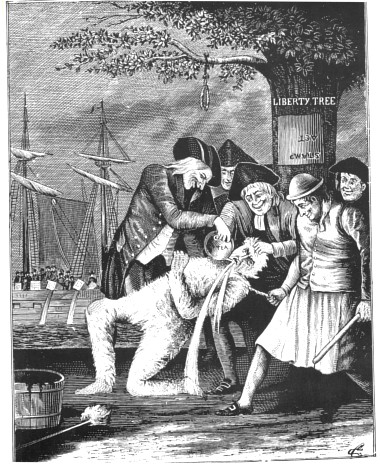Loyalists
- From the History Teaching Institute at Ohio State University is: Loyalists and Loyalism in the American Revolution.
- The Encyclopedia Britannica, "Loyalist," includes political cartoons.
- Loyalist Lesson Plans from Lesson Planet.
- From FactMonster, "Loyalists."
- From the BBC, "Was the American Revolution Inevitable?"
- The On-Line Institute for Advanced Loyalist Studies
- Lesson Plan: South Carolina: Loyalist or Patriot?
 A
Loyalist being tarred and feathered, 1770s.
A
Loyalist being tarred and feathered, 1770s.Loyalists were those those colonists who affirmed Britainís authority over the colonies. The political complexion between 1775 and 1783 is accurately described as equally divided among patriots, loyalists, and those diffident or disaffected. Between 60,000 and 80,000 Americans chose to go into exile after 1783. Among these were many of the ablest and wealthiest men in colonial life, but the group also included ordinary men and women, as well as a thousand black loyalists who eventually settled in Sierra Leone. In a tri-racial society, Native Americans were also forced to choose sides.
The number of Loyalists in each colony varied. Recent estimates suggest that half the population of New York was Loyalist; it had an aristocratic culture and was occupied throughout the Revolution by the British. In the Carolinas, back-country farmers were Loyalist, whereas the Tidewater planters tended to support the Revolution.
During the Revolution, most Loyalists suffered little from their views. However, a minority, about 19,000 Loyalists, armed and supplied by the British, fought in the conflict.
The Paris Peace Treaty required Congress to restore property confiscated from Loyalists. The heirs of William Penn in Pennsylvania, for example, and those of George Calvert in Maryland received generous settlements. In the Carolinas, where enmity between rebels and Loyalists was especially strong, few of the latter regained their property. In New York and the Carolinas, the confiscations from Loyalists resulted in something of a social revolution as large estates were parceled out to yeoman farmers.
About 100,000 Loyalists left the country, including William Franklin, the son of Benjamin, and John Singleton Copley, the greatest American painter of the period. Most settled in Canada. Some eventually returned, although several state governments excluded the Loyalists from holding public office. In the decades after the Revolution, Americans preferred to forget about the Loyalists. Apart from Copley, the Loyalists became nonpersons in American history.
(Source: "Loyalists in the American Revolution" from the U.S. Dept. of State)